
Plants get their energy from the sun through photosynthesis. They can do so because their cells contain a bio-molecules called chloroplasts, which make up a family of pigments known as chlorophylls.
The white sunlight is a mixture of all colors of the light spectrum, but chlorophylls involved in the process of transforming solar energy into chemical energy absorb only light of certain wavelengths, or certain colors, in ranges corresponding to blue and red. Plants do not use the green light spectrum and reflect it. This is the reason why we see the leaves green, because green is not used for photosynthesis light anf then its is reflected by the leaves.
In healthy state, the plants not only reflect the green light from the solar spectrum: they also reflect the so-called "near infrared" or wavelengths of sunlight that are located just below the red, which itself is absorbed by chlorophyll in photosynthesis.
All these characteristics of absorption and reflection of different wavelengths are useful and in fact are widely used to assess the health status of a plant: A healthy leaf absorbs blue and red light for photosynthesis, while reflecting green light and near infrared light.
One of the ways in which these characteristics are traditionally exploited is by analyzing multispectral satellite imagery. More recently people started taking pictures using UAVs (drones), which carry onboard multispectral cameras, ie cameras capable of recording not only visible light but also other bands of the spectrum of sunlight, as ultraviolet and infrared light.
ImScope is an application for Android and an experimental tool oriented to visualization and recording of indicators of plant health by image and video processing on mobile phones and tablets, using a variety of filters and indices that are commonly used, some simply on the visible light captured by the camera, and others trying to take advantage of a small fraction of light that manages to pass NIR filter that blocks infrared on mobile devices.
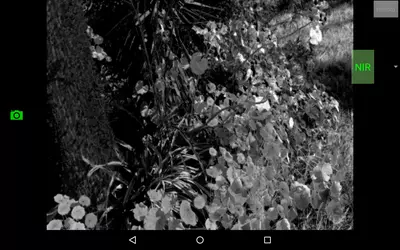
NIR
Cameras that come with smartphones and tablets are sensitive to near infrared radiation, but these wavelengths above 700 nanometers that separate from red, are BLOCKED almost entirely by a built-in optical filter. This blocking filter is needed for the invisible infrared light does not interfere with the colors captured in the normal use of the camera.
However, a small part of the NIR (near infrared) radiation gets through the filter. This may be checked by activating a remote control (eg a TV) targeted to camera phone. You can see how the infrared remote control LED lights up when you press the buttons, for example when switching channels.
In NIR mode, ImScope shows a monochromatic representation in which white aims to be proportional to the near infrared reflected . Again: since normal camera phones and tablets have a filter that blocks infrared light, NIR value is not really acquired but estimated by calculation from the visible colors, color saturation, etc. This rough estimate is used in all indexes and is only useful for the leaves and conditions of direct sunlight.
From NIR channel estimation, the following modes are possible 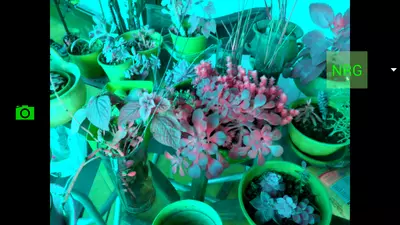
NRG
Transposed colors mode in which the intensity of the red corresponds to the estimated near infrared , green correspond to acquiered red and blue to acquired green.
NRG > RGB

NGB
Transposed colors mode in which the intensity of the red corresponds to the estimated near infrared while green and blue are preserved unchanged.
NGB > RGB
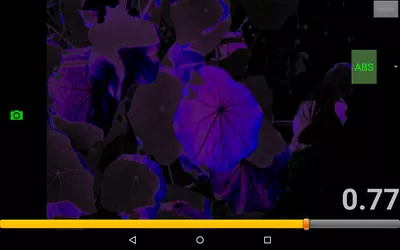
ABS
In this mode red aims to be proportional to the red light absorbed by the object, and blue aims to be proportional to the absorbed blue light. The displacement bar allows you to mix some gray to the context. This mode can be useful since the fact that the two types of chlorophyll (chlorophyll A and chlorophyll A) absorb red light and blue in different proportions.

Indexed modes:
For all following modes the slider control allows you to select a coeficient that goes from 0 to 1 such that:
- RED color corresponds to points that have an index value very close to the selected index value,
- GREEN color corresponds to points that have an index value close to the selected index value decreased by -0.2 .
- BLUE color corresponds to points that have a value close to the selected index value decreased by -0.3
- All other points are presented in grayscale.
That means for example if a NDVI index of 0.7 is selected, RED correspond to points close to that value index, GREEN to points with NDVI index near 0.5, and BLUE to points with value near 0.4. In this way, by adjusting the slider control, you can capture subtle differences between areas of the image.
Indexes calculations:
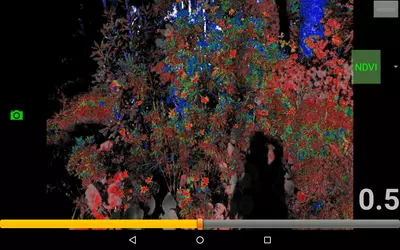
NDVI
(NIR-RED) / (NIR + RED) (please remember: NIR is only an derived estimation on normal phones and tablets with IR blocking filters
VIGreen
(GREEN-RED) / (GREEN + RED)
VARI
(GREEN-RED) / (GREEN + RED-BLUE)
GRI
GREEN % - RED % = relative difference between green and red
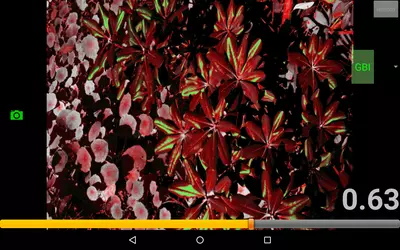
GBI
GREEN % - BLUE % = relative difference between green and blue
GI
GRI + GBI = sum of above relative differences
Interpretation of results
Since interpretation of the results obtained by this application exceeds our expertise, we let such an interpretation for biologists, botanists and agronomists, who are invited to install Imscope, experiment with it and draw their own conclusions!
